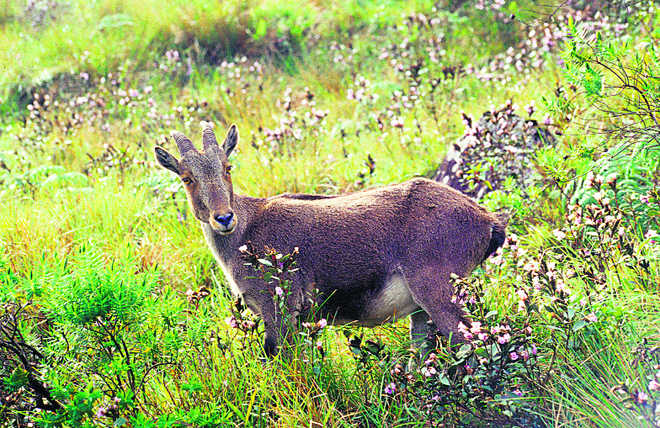
Saving the goat: Tahr, listed in the IUCN Red Data Book, is today the mascot of Eravikulam
Susheela Nair
As our vehicle plodded up the hills to Munnar, the road was jampacked with vehicles ferrying tourists and nature enthusiasts heading to Rajamalai, the tourism zone of Eravikulam National Park. Though the heavy rains, frequent landslides and the serpentine queues posed a daunting challenge, it did not dampen our enthusiasm to witness the spectacular flowering of the neelakurinji, which happens once in 12 years here.
En route we tarried awhile by the Interpretation Centre called the ‘Story of the Park,’ which provides interesting insights, wildlife exhibits and captivating visuals, about the ecosystem and the history of the park. From there, we took a short stroll along the road through the grasslands. The valley view from the park is stunning. The park exhibits emerald grasslands interspersed with wooded valleys, shrub land and shola forests, crisscrossed by cold, clear streams. Anaimudi, the highest peak of South India, which towers 2,695m (98,841ft), also has its home inside this park.
Apart from neelakurinji, one can see a profusion of the red rhododendrons, flame of the forest and myriads of terrestrial orchids and balsams in this shola-grassland ecosystem. An orchid (Brachycorythis wightii) that was long thought to be extinct was rediscovered in this part of the park. The park also shelters other lesser-known animals such as Nilgiri marten, small clawed otter, ruddy mongoose, and dusky striped squirrel, small Indian civet, sambars, gaurs, macaque, the occasional tiger or leopard and wild dogs, the most feared predators of the grasslands.
Birdwatchers can keep an eye out for avifauna, including endemic species like black and orange flycatcher, Nilgiri pitpit, Nilgiri wood pigeon, white-bellied shortwing, Nilgiri verditer flycatcher and Kerala laughing thrush. 100-odd butterflies can be spotted including endemic ones confined to the shola-grassland ecosystems like the red bush brown and Palni four wing.
Moving further ahead, we followed the footsteps of the endangered Nilgiri tahr (wild mountain goats). It is here in the downs and crags of Rajamalai that you can sight the mountain goats. They live in herds on the steep black rocky slopes of the national park. It is a delight watching these agile footed animals rummaging for grass and the playful young ones prancing up and down the sheer cliffs.
During the hunting frenzy of the colonial era, the goats were slaughtered by the British settlers. Their population dwindled drastically as a result. It was the doing of the army of the Duke of Wellington, who camped here during his offensive against Tipu Sultan. The tame and friendly goats unfortunately became a favourite item on the camp menu. It was poached into extinction in the 1950s, before an NGO stepped in and ensured the mountainous habitat was declared a sanctuary.
The Nilgiri Tahr Foundation was formed to spread the message of conservation. Today, the animals roam around freely, largely thanks to the efforts of Clifford Rice and the High Range Wildlife & Environment Preservation Association (HRGWEPA). Eravikulam’s estimated tahr population is around 900, making it the largest viable population in the world. The incredibly agile tahr, a highly endangered animal, listed in the IUCN Red Data Book, is today the pride of Eravikulam and its mascot.
The park’s metamorphosis from an erstwhile hunting preserve of the British settlers to the country’s cleanest and most well-managed National Parks is a fascinating story. It was declared a Wildlife Sanctuary in 1975 and a National Park in 1978. The High Ranges Game Preservation Association managed the area as a game preserve for the erstwhile Kannan Devan Hills Produce Company by employing the Muduvan tribals, the original inhabitants of these hills known for their tracking skills, as game watchers.
The planter community and the Muduvans continue their association with the protection and management of the park along with the forest department. Eravikulam currently exemplifies efficient protection and management of biodiversity at its best.



























